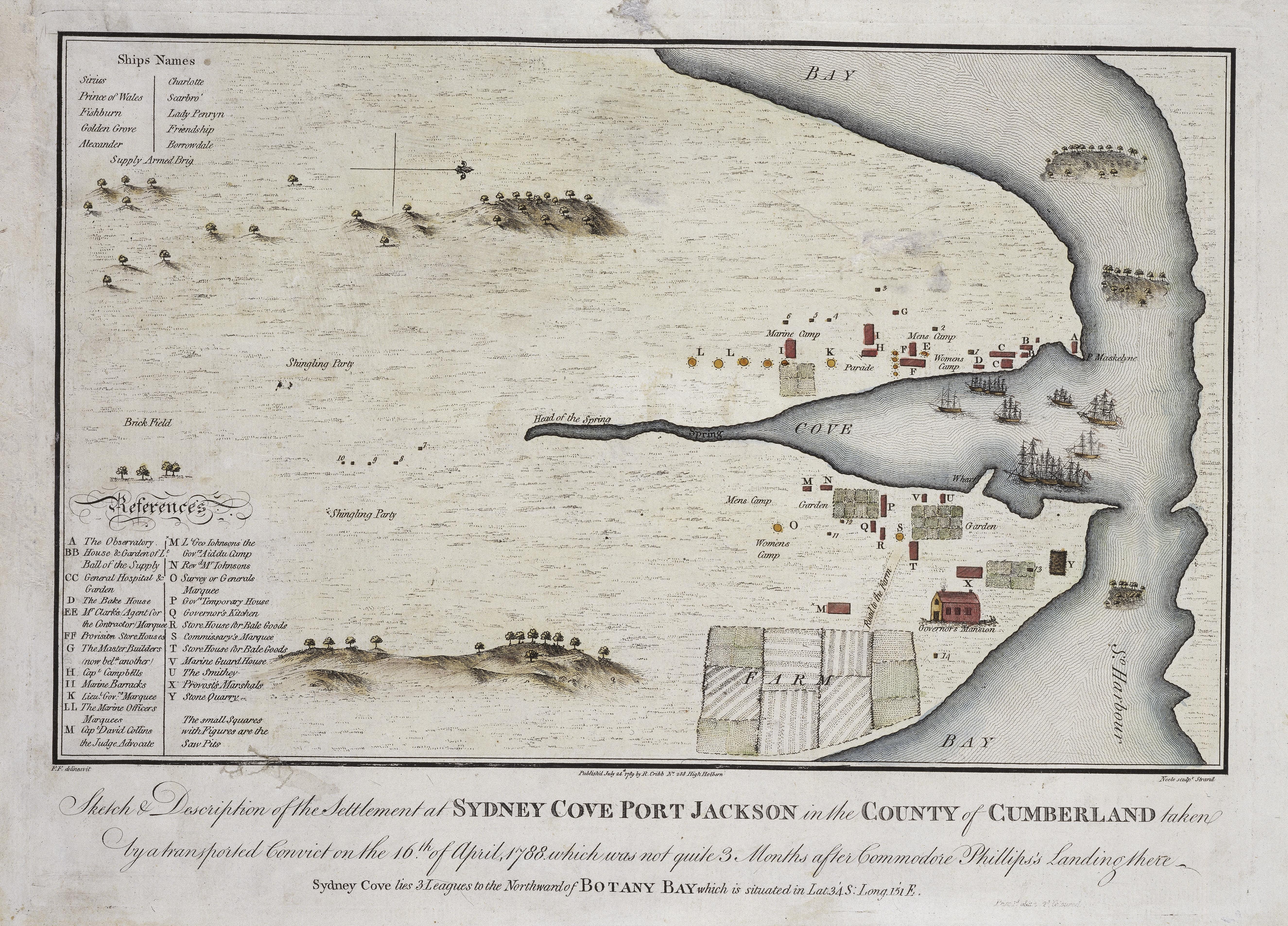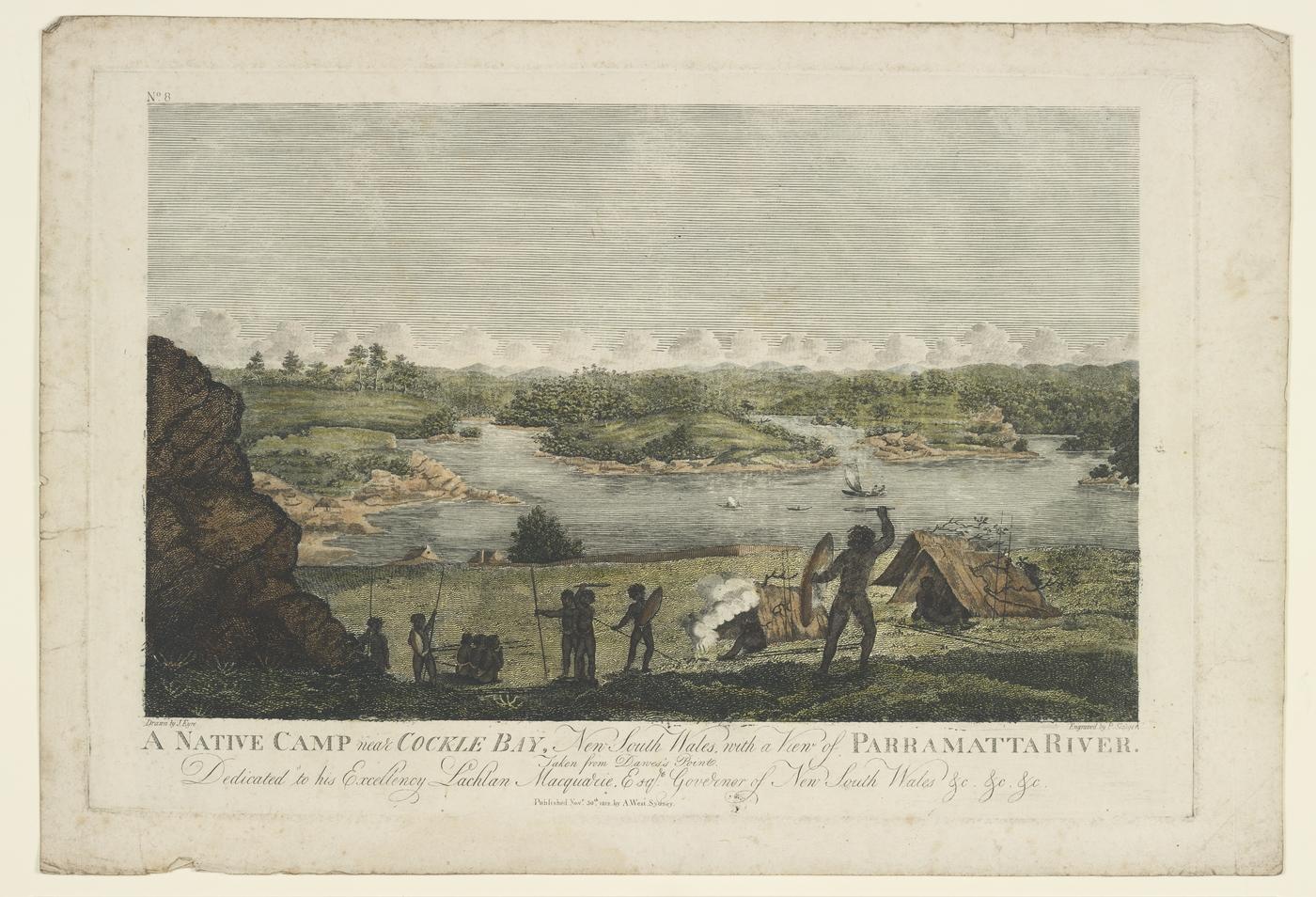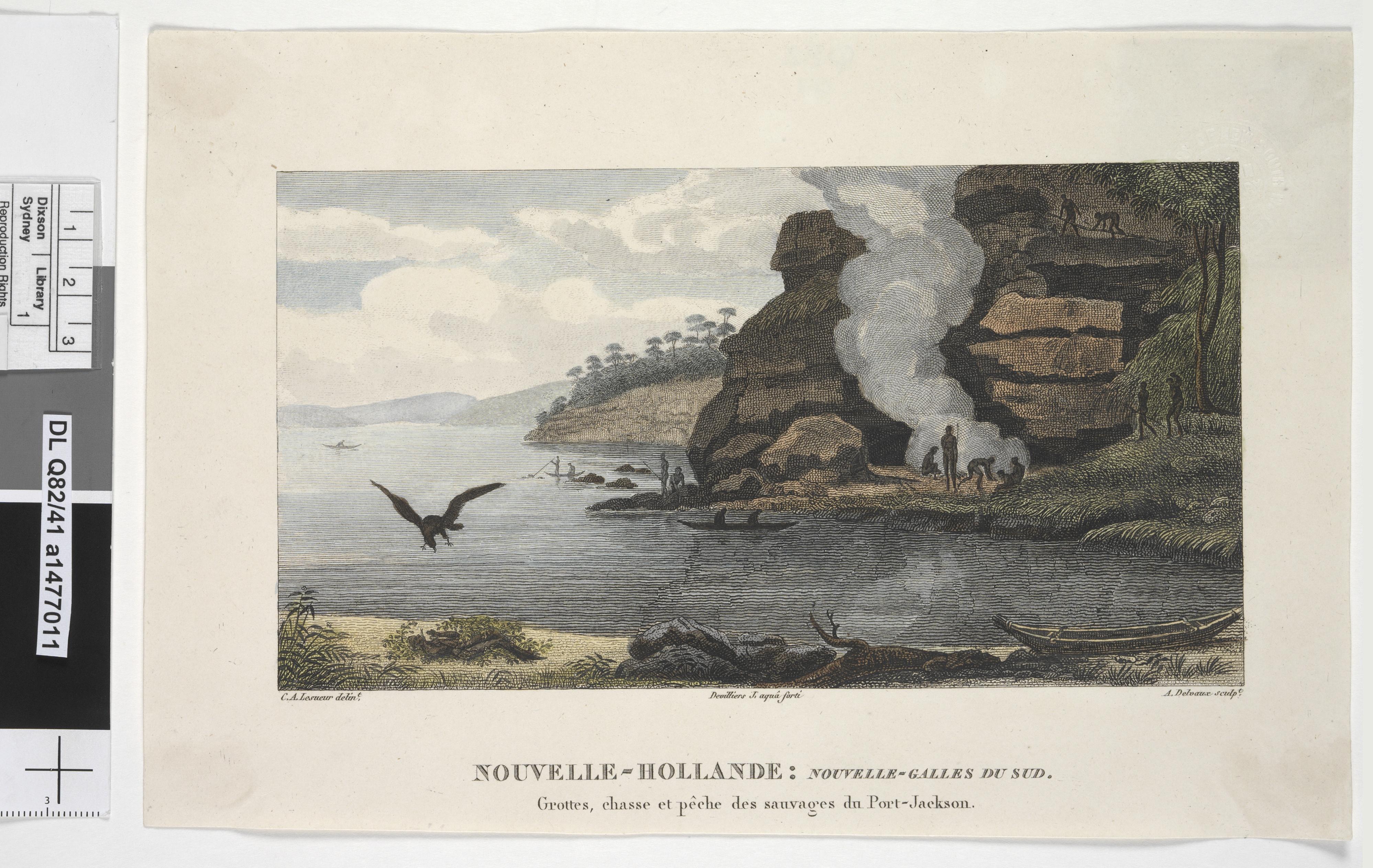Aboriginal homes
Students interrogate the concept of terra nullius, examine Aboriginal homes and consider the impact of British settlement.
This is the student activity 1 of 7 of the Setting up camp learning activity.
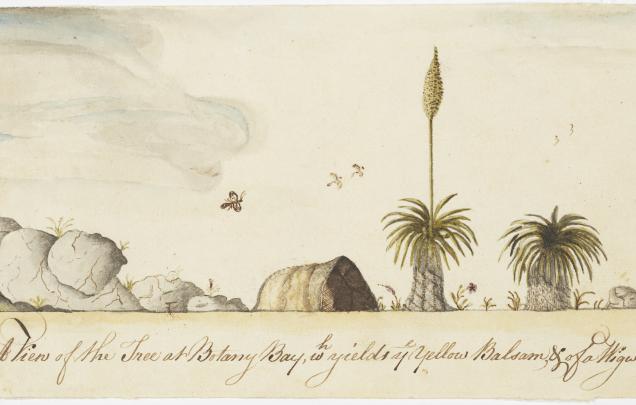
Interrogating terra nullius
The First Fleet ships were filled with tools and supplies from England to help the new arrivals build their shelters on the shores of Warrane/Sydney Cove.
The British Government treated this land as though it was terra nullius. The term terra nullius means ‘land belonging to no one’.
Answer these questions:
- Was terra nullius true?
- If the colonisers on the First Fleet believed the land to be terra nullius, how did that affect their decisions they made on arrival?
When the First Fleet arrived they did not ask permission or get consent from the Aboriginal people to land or visit. This was very bad manners - you would not do that when visiting someone’s home. By not asking permission showed that the British Government believed the concept of terra nullius. Even though they knew that Aboriginal people did live here, they tried to justify saying the land belonged to nobody because there wasn’t a single authority or ruler for the colonisers to negotiate with, there were no established written laws or agricultural practices that they understood, and they didn’t see evidence of permanent homes that might have signified ownership to them.
Answer this question:
- If you arrived at a new place and you saw people and their homes, as well as things like spears, fishing lines and fish-hooks, would you believe this land belonged to no one? Why?
Read what Bruce Pascoe, author of Young Dark Emu: A Truer History, writes in 2019 on page 8:
It is clear from the journals of the of early settlers and explorers that few came to Australia to marvel at a new civilisation – they had come to replace it.
And,
They considered it their duty to expand the British Empire.
Discuss the ideas raised in these statements.
There is evidence of Aboriginal agricultural practices where crops were planted, irrigated and harvested. Surplus seed was stored for the future. The use of fish traps was a well-established practice. There is evidence of places being used as residences over thousands of years of permanent structures, dams and wells. Aboriginal communities had been shaping and caring for the land for tens of thousands of years before the colonists arrived.
Read Bruce Pascoe’s words about Aboriginal history from Dark Emu: Aboriginal Australia and the Birth of Agriculture in 2018 on page 183:
Aboriginal people did build houses, did build dams, did sow, irrigate and till the land, did alter the course of rivers, did sew their clothes, and did construct a system of pan-continental government that generated peace and prosperity.
Answer this question:
- Do you believe the land was terra nullius?
Warrane and water
We know that there was already a civilisation living on this land for over 65 000 years. Aboriginal people had been building secure, permanent homes using materials from the local area. They had been growing and providing food for families and communities using agricultural practices for countless generations. [For more information on this topic refer to Bruce Pascoe’s book Young Dark Emu: A Truer History.]
The freshwater stream that flowed through the land close to Warrane/Sydney Cove had been a source of water for the local Aboriginal people for as long as they have lived there. They looked after Country using practices and natural resources without destroying the environment in the process.
Look at the map, below, showing the freshwater stream, labelled a spring, in April 1788.
Read Judge David Collins’ description of the freshwater stream when the First Fleet arrived in January 1788:
the run of fresh water, which stole silently along through a very thick wood, the stillness of which had then, for the first time … been interrupted by the rude sound of the labourer’s axe, and the downfal of its ancient inhabitants.
Look at the images, below, of the freshwater stream in 1788, 1794 and 1803. The arrow shows the location of the water flowing along the land to the sandy shore of Warrane/Sydney Cove. This freshwater stream was given the name Tank Stream in 1790 when storage tanks were cut into the sandstone beside the stream to collect water.
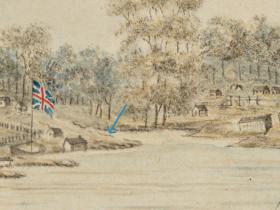
In the image below, the tank stream runs through the valley that runs across the centre of the image.
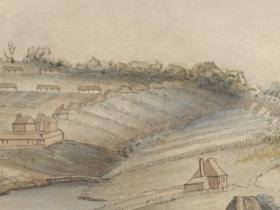
In the image below, the tank stream is painted as having blue water.
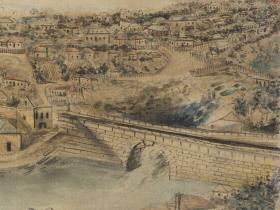
In the images from 1794 and 1803 notice what is missing beside the Tank Stream compared to the 1788 image, and consider David Collins’ words about the thick wood and axes chopping down these ancient inhabitants that were growing next to the stream.
Answer these questions:
- What has disappeared? What is the effect? [Answer in Additional Information.]
- In all the images, what buildings or construction do you notice close to the Tank Stream? How might these have had an impact on the stream?
- In the early days, how could the introduced animals, like cows and pigs, impact the Tank Stream? [Answer in Additional Information.]
- What impact did the loss of access to this freshwater stream have on Aboriginal people? [Answer in Additional Information.]
- How many years had these traditional owners been successfully looking after this freshwater stream?
- Guess how many years it took the colonists to destroy it? [Answer in Additional Information.]
Did you know? In the third image above you can see a bridge built across the Tank Stream. That is the location of Bridge St today!
Compare and discuss the two approaches to caring for this freshwater stream by Aboriginal people and the colonists.
Research the Tank Stream today and answer these questions:
- Where is the Tank Stream today?
- What condition is it in?
- Can you visit it? Look this up online.
Home and Country
Examine the visual primary sources, below, about Aboriginal homes.
Read what Captain Watkin Tench, between 1789 and 1791, described the Aboriginal homes he saw as:
…a little village
And,
Their hut … composed of pieces of bark , in shape as like a soldier's tent: but long and wide enough to admit three or four persons to lie under it… With a lighted stick brought from the canoe, they now kindle a small fire, at the mouth of the hut, and prepare to dress their meal.
Captain John Hunter noted a few days after arrival in 1788 that the Aboriginal people he saw:
Generally Shelter themselves in such Cavitys or hollows in the Rocks upon the Sea Shore as may be Capable of defending them from the Rain, and in order to make their appartment as Comfortable as possible, they Commonly make a good fire in it.
Surgeon George Worgan recorded in 1788:
They make these Huts their constant Habitations.
Define the term constant habitations.
Answer these questions:
- Who wrote and drew these sources?
- Where did Aboriginal people get their building materials from? How is this different to or the same as the First Fleeters?
- David Collins described the Aboriginal shelters as comfortable. Based on your work in the previous tasks, do you think the convicts would describe their own shelters in the same way?
- Does the definition of constant habitations and the words village and apartment conflict with the colonists’ belief in terra nullius, ‘land belonging to no one’? Discuss this idea.
- Do you think all the First Fleeters actually believed that Australia was ‘land belonging to no one’?
The European attitude to land ownership is very different to the Aboriginal understanding of Country. European people believed that people own land, while in Aboriginal cultures people belong to the land and have responsibilities to care for Country.
Watch the video, here, of Uncle Lloyd Walker, a Dharawal man, welcoming people to Coastal Sydney and to the State Library in 2019.
Answer these questions:
- How does Uncle Lloyd describe his people’s connection to the land?
- Who are the ‘old people’ Uncle Lloyd talks about? How did he learn about their lives?
- How is this source of information different from the quotes and images above?
- Why is it important to look at multiple sources from many people's perspectives?
The holding and passing down of knowledge orally is an important Aboriginal tradition. These oral histories are another important source of historical information.
Answer this question:
- Can Aboriginal oral first-hand narratives be considered primary sources? Why or why not?
Aboriginal people at the time tried to teach the First Fleeters about the significance of Country, but it was not well understood by the Europeans. Bennelong was a Wangal man who taught the Europeans about Aboriginal language and customs. He tried to explain the concept of Country to Judge David Collins in 1796, who wrote:
they have also their real estates. Bennillong, both before he went to England and since his return, often assured me, that the island Me-mel (called by us Goat Island) close by Sydney Cove was his own property; that it was his father’s …To this little spot he appeared much attached; and we have often seen him and his wife Ba-rang-a-roo feasting and enjoying themselves on it. He told us of other people who possessed this hereditary property, which they retained undisturbed.
Answer these questions:
- Are the terms real estate, his own property and hereditary property appropriate to describe Bennelong’s connection to county? Why do you think David Collins chose those words?
- Why would it be important for Bennelong to communicate that he looked after Me-mel Island?
Today we might say that Bennelong was the custodian of Me-mel Island, that it was his Country.
Write a more accurate description of Bennelong’s relationship to Me-mel Island.
At Warrane/Sydney Cove the landscape changed dramatically as the Europeans cleared the bush to make a campsite that then expanded into the permanent town.
Answer these questions:
- What impact did the bush clearing have on the environment?
- Considering Aboriginal peoples’ connection to Country, what do you think they were thinking when they witnessed the removal of clay for bricks, the cutting of stone out of the ground and the destruction of trees?
Discuss:
- Do you think the European people had a good understanding of Aboriginal life and culture at this time? How does this change the way you think about their observations in the primary sources above?
- What do you think the European people could have learned about living in Australia from the Aboriginal people?
- Why do you think the British government continued to claim that Australia was terra nullius, even though their own representatives recorded evidence that it was not?
Enormous change occurred for the Aboriginal people living in Warrane. A few Aboriginal people chose to live in and around the area where the First Fleet had settled.
Read what Lieutenant William Bradley in February 1791, noted that Aboriginal people:
…had lately become familiar; several of them staying cheifly in the Camp & at the Governors.
Answer these questions:
- Why do you think some Aboriginal people chose to use the huts provided by the Governor and even stay at the Governor’s own residence?
- How do you think Aboriginal people would have described to their friends and family their experiences of staying in these First Fleet buildings?
After 1790 more Aboriginal people ventured into the township and everyone spent more time together. [For more information about the circumstances of this change, see Activity 2, Abduction, of the Fighting Back learning activity.]
Aboriginal people and the First Fleet convicts would have had some interaction and communication but sadly there are few records of this contact.
Write an imagined conversation between an Aboriginal child and a young convict discussing their lives. Illustrate this work with drawings of their homes.
